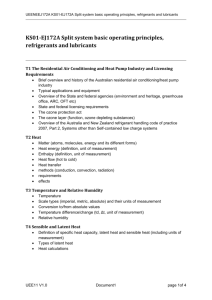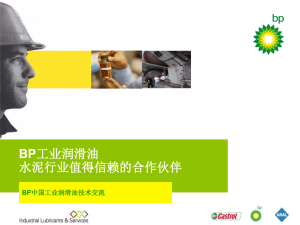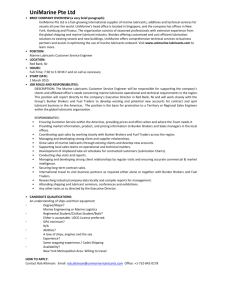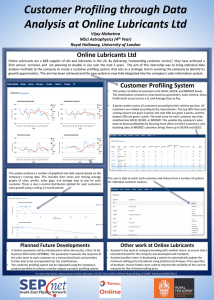Dr S. J. Randles Uniqema
advertisement
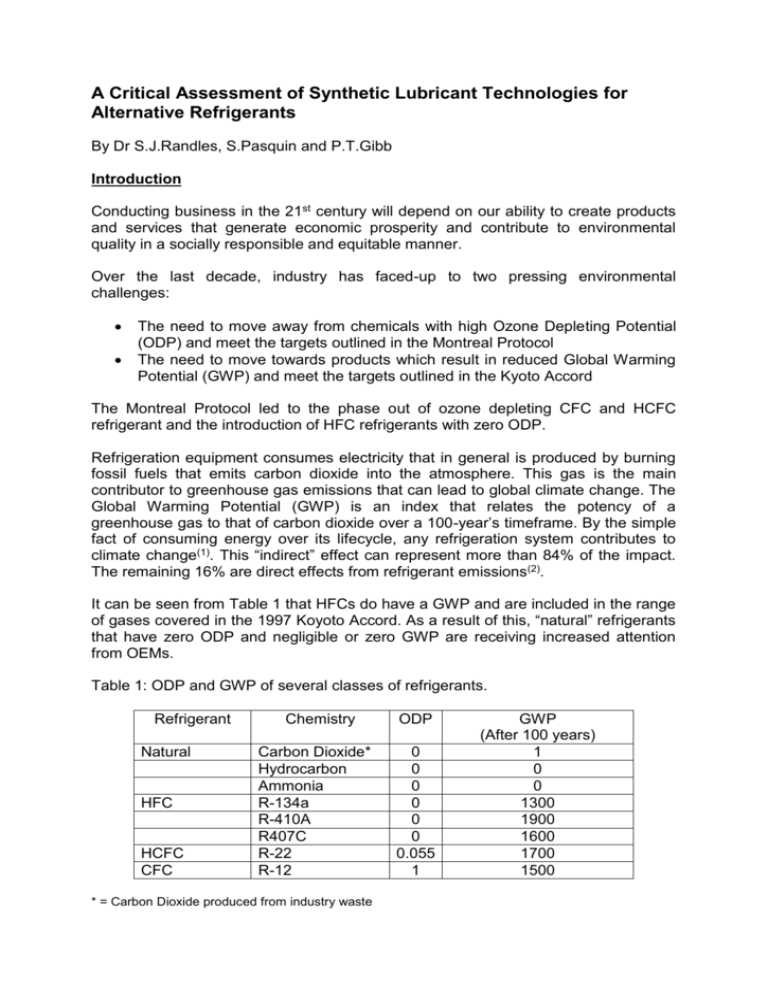
A Critical Assessment of Synthetic Lubricant Technologies for Alternative Refrigerants By Dr S.J.Randles, S.Pasquin and P.T.Gibb Introduction Conducting business in the 21st century will depend on our ability to create products and services that generate economic prosperity and contribute to environmental quality in a socially responsible and equitable manner. Over the last decade, industry has faced-up to two pressing environmental challenges: The need to move away from chemicals with high Ozone Depleting Potential (ODP) and meet the targets outlined in the Montreal Protocol The need to move towards products which result in reduced Global Warming Potential (GWP) and meet the targets outlined in the Kyoto Accord The Montreal Protocol led to the phase out of ozone depleting CFC and HCFC refrigerant and the introduction of HFC refrigerants with zero ODP. Refrigeration equipment consumes electricity that in general is produced by burning fossil fuels that emits carbon dioxide into the atmosphere. This gas is the main contributor to greenhouse gas emissions that can lead to global climate change. The Global Warming Potential (GWP) is an index that relates the potency of a greenhouse gas to that of carbon dioxide over a 100-year’s timeframe. By the simple fact of consuming energy over its lifecycle, any refrigeration system contributes to climate change(1). This “indirect” effect can represent more than 84% of the impact. The remaining 16% are direct effects from refrigerant emissions(2). It can be seen from Table 1 that HFCs do have a GWP and are included in the range of gases covered in the 1997 Koyoto Accord. As a result of this, “natural” refrigerants that have zero ODP and negligible or zero GWP are receiving increased attention from OEMs. Table 1: ODP and GWP of several classes of refrigerants. Refrigerant Natural HFC HCFC CFC Chemistry Carbon Dioxide* Hydrocarbon Ammonia R-134a R-410A R407C R-22 R-12 * = Carbon Dioxide produced from industry waste ODP 0 0 0 0 0 0 0.055 1 GWP (After 100 years) 1 0 0 1300 1900 1600 1700 1500 This paper will focus on the lubricant issues raised by the use of alternative refrigerants. Hydrocarbons (R-600a, R-290) The utilization of hydrocarbon refrigerants such as propane and isobutane in domestic appliances, air conditioning and heat pumps has received a great deal of attention. ISO 10 to ISO 22 mineral oils are typically the lubricant of choice for R-600a domestic compressors. Generally, they have performed well except for a few issues connected with their high solubility. Mineral oils, being hydrocarbons, have high solubility in hydrocarbon refrigerants (like-dissolves-like). High solubility can lead to: - foaming, excessive lubricant dilution leading to potential wear problems and high oil carryover leading to slugging. Foaming and wear have been overcome by the use of traditional antifoaming and antiwear additives. However, high oil carryover has lead to oil slugging issues in certain systems and this can lead to markedly reduced energy efficiency over time. Esters and polyalkylene glycols (PAG) have lower solubility in R-600a refrigerants and can markedly reduce oil slugging. Polyalylene glycol lubricants tend not to be used due to difficulty in making them at very low viscosities (<ISO 22) and material compatibility issues. Diesters, polyols esters (POEs) and blends of esters with hydrocarbon lubricants (mineral oils, poly alpha olefins (PAO) and alkyl benzenes (ABs)) have been shown to give excellent performance with R-600a. Their excellent lubricity and reduced solubility allow ISO 7 lubricants to be used with R-600a and ISO 22 to 32 lubricants with R-290. The lower viscosity and reduced oil slugging of esters has shown efficiency benefits of up to 5% when compared with mineral oil when tested in the same R-600a system. Carbon Dioxide (R-744) Carbon dioxide is an excellent refrigerant because it is non-toxic, non-flammable, has excellent heat transfer characteristics and is inexpensive. It has zero ODP and has a net zero GWP when obtained from an industrial waste or by-product source. Carbon dioxide has therefore attracted attention in several applications such as automotive air-conditioning and heat pumps. However, there are several potential issues that will impact on the selection of the lubricant, namely: - - - Lubricant Transport o To ensure good oil return to the compressor, in refrigeration systems having liquid pools such as oil reservoirs, etc., the refrigerant oil needs to have either A higher density than the CO2 refrigerant or Good miscibility with it. Wear o CO2 is an excellent solvent and this solvency can cause excessive lubricant dilution leading to potential wear and foaming problems o CO2 requires the use of higher operating pressures (e.g. in automotive A/C the working pressure becomes one order higher compared to HFCs(3)). High load increases stresses on bearings which can lead to increased wear Stability o CO2 can react with water to forms carbonic acid that can then accelerate potential hydrolysis processes. Lubricant Transport Mineral oils have poor miscibility with carbon dioxide. Table 2 gives a summary of the miscibility of carbon dioxide with a range of lubricants. Table 2: Overview of miscibility of carbon dioxide with a range of synthetic lubricants. Lubricant Mineral Oil PAO Alkyl Benzene Esters PAG Miscibility Immiscible Immiscible Immiscible Miscible Partially Miscible As can be seen in Figure 1, carbon dioxide changes density very rapidly with temperature. This can result in a poorly miscible lubricant, at certain temperatures, floating on liquid refrigerant while at other temperatures sinking. This property is known as “phase inversion” and can be problematic in terms of oil separation. Fully miscible lubricants avoid this issue. Figure 1: Change in Density versus temperature for a range of lubricants(4) 1.2 Density in g/cm3 1.1 PAG POE 1 MO AB 0.9 0.8 CO2 0.7 0.6 0.5 -30 -20 -10 0 10 Temperature in `C 20 30 40 Due to their superior miscibility behaviour when compared to mineral oils; POEs, diesters and PAGs have undergone further studies. Wear Vapour Liquid Equilibria (VLE)/Vapour Pressure Temperature (VPT) diagrams for ISO 32 POEs, diesters and PAGs and given in Figure 2. Figure 2: VLE diagram for POEs, diester and PAGs with CO2 500 100% Oil 100 Viscosity (cSt) 50 90% Oil 10 5 PAG 70% Oil POE 1 Diester 0.5 0 10 20 30 100 40 50 60 Temperature (°C) 70 80 90 100 70% Oil Diester 80 Pressure (bar) POE PAG 60 90% Oil 40 20 0 0 10 20 30 40 50 60 Temperature (°C) 70 80 90 100 Since the viscosity of liquid CO2 is very low, the more CO2 dissolves in the lubricant the more it can dilute the viscosity of the mixture. POEs are very soluble in CO 2 and this can lead to a marked viscosity reduction. It can be seen from Figure 3, for an ISO 32 lubricant CO2 reduces the viscosity of an oil much more than R-134a. This has to be compensated for by an increase in viscosity of the ester. Figure 3: VLE diagram of an ISO 32 POE with R-134a and CO2 200 100% Oil 100 50 Viscosity (cSt) 90% Oil 10 5 70% Oil R-134a R-744 1 0 10 20 30 60 50 40 Temperature (°C) 70 80 90 100 100 70% Oil Pressure (bar) 80 60 90% Oil 40 70% Oil R-744 20 R-134a 90% Oil 0 0 10 20 30 40 50 60 Temperature (°C) 70 80 90 100 The high solubility of CO2 in POE in certain systems can lead to foaming issues but this can be resolved, where required, by the use of conventional antifoaming agents. The high loads in certain systems may require the use of antiwear additives. Stability Higher levels of moisture may be also be present in the lubricants as water has less affinity for CO2 than it does for HFCs. Water can also react with CO2 to form carbonic acid. There are therefore legitimate concerns over possible stability and copper plating issues that could arise from these factors. In automotive applications detailed testing has shown that double end-capped PAGs perform well(5). Double end-capped lubricants are preferred as they do not possess terminal hydroxyl groups and thereby improve stability by: - reducing the possibility of chemical reaction (residual hydroxyl groups can react with carbonic acid) and reducing their affinity for moisture. Esters, due to their excellent solubility, have been used in heat pump applications. With esters there is obvious concern around the potential for hydrolysis. The hydrolysis issue, as found with HFC systems, may not be as problematic as first thought. Provided correct handling procedures are followed esters have been shown to work well. In fact, esters (and PAGs) have been used for an number of years as CO2 process gas lubricants without issue. Careful selection of antiwear additives is required, as they tend to be much more hydrolytically sensitive than the lubricant. As with HFC systems, traditional copper deactivators can alleviate copper plating in systems where this is an issue. In summary, a range of lubricants can be used for carbon dioxide applications. In certain systems synthetic hydrocarbons such as PAOs and ABs can be still used even though they have poor solubility. The poor solubility of the synthetic hydrocarbons is compensated for by their excellent low temperature flow properties and can be improved still further by blending with more miscible lubricants (e.g. PAGs, esters, etc.). A range of individual and blends of synthetic lubricants are therefore being evaluated to find the more cost effective solution for a particular application. Quite often lubricant selection will be based on logistic factors, i.e. a lubricant that can work with a variety of refrigerants. Ammonia (R-717) Ammonia has zero ODP and GWP, however limitations include strong odour and a limited range of flammability in air. Even with these limitations ammonia is being considered for applications with limited exposure to dense populations (e.g. rooftop air-conditioning, water chillers, etc.). PAGs are soluble in ammonia. This allows the use of ammonia in refrigeration systems with direct expansion (DX) evaporators. The use of such systems has resulted in markedly reduced refrigerant charge (1/10 th to 1/50th) when compared to that of conventional systems(6). End capped PAGs are again preferred due to their superior stability and lower affinity for moisture. Moisture can be reduced still further by the use of ethylene oxide in the polymer chain. This produces the property of “inverse solubility”. Simply put, inverse solubility means the hotter the lubricant becomes the less soluble water becomes. Below 60°C – 70°C (cloud point) water is completely absorbed into the lubricant. Above this temperature it completely phase separates. By keeping the discharge temperature above the cloud point the moisture level in the PAG can be kept low. Immiscible types of synthetics oils such as PAOs and ABs or highly processed hydrocracked oils are used in traditional ammonia systems where their excellent low temperature properties allow for operations at very low temperatures. Quite often, blends of several synthetic lubricants (e.g. AB/PAO) will be used to optimise performance(7). Polyol esters are known chemically to react with ammonia to form solids and are therefore avoided. Conclusions Synthetic lubricants can offer many advantages when used with alternative refrigerants. Most of the direct advantages relate to the ability to change the chemistry of the lubricant to obtain an optimum lubricant solubility. This optimisation has a direct and important impact on key performance criteria such as efficiency and reliability. References 1. 2. 3. 4. 5. 6. 7. HFCs, Refrigeration and air-conditioning minimising climate impact and maximising safety. Pamphlet produced by the European Partnership for Energy and the Environment (EPEE). Http://www.epeeglobal.org March Consulting Group. (1998). Opportunities to minimize emissions of hydrofluorocarbons (HFCs) from the European Union. Final Report. Prepared by March Consulting Group, United Kingdom, for the European Commission. S.Komatsu, M.Tsunoda and S.Yamamato. (December 2000). Development of automotive air conidtioing system using carbon dioxide. The international symposium on HCFC alternative refrigerants and environmental technology 2000. The Japan Refrigeration and Air Conditioning Industry Assosiation. Kobe. pp 80-83. Paper 4.2. T.Hagita, H.Kobayashi, M.Takeuti, T.Itiyanagi, N.Horaguti and T.Ukai. (December 2000). The development of CO2 scroll compressor for automotive air-conditioning systems. The international symposium on HCFC alternative refrigerants and environmental technology 2000. The Japan Refrigeration and Air Conditioning Industry Assosiation. Kobe. pp 48-51. Paper 2.4. Y.Kawaguchi, M.Takesue, M.Kaneko and T.Tazaeki. (July 2000). Performance study of refrigeration oils with CO2. Society of Automotive Engineers. http://www.sae.org/misc/ac/presentations/idemitsu.pdf H.Takahashi. (February 2000). An introduction of miscible refrigeration oil for ammonia refrigerant. Refrigeration, Vol. 76. No. 868, pp 111-114. J.Oberle and T.Rajewski. (March 1997). The development of lubricants for ammonia refrigeration systems. IIAR 19th Annual meeting. New Orleans, Lousiana, USA.



